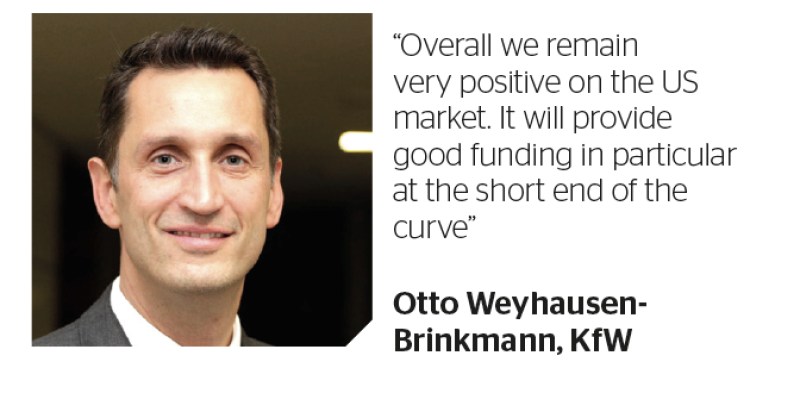The level of the euro/dollar basis swap meant that for much of 2018 euro funders shunned dollars, but when they came they found a rock solid market — that often provided enticing prices as deal starved investors snapped up paper.
Dollar issuance from developed market SSA borrowers was at $223bn in late November, down from $283bn in 2017 and at its lowest annual level since $200bn in 2012, according to Dealogic. As a share of total funding, in 2018 dollars amounted to 23.5% at the end of November, down from 26.8% in 2017 and the lowest share since 22.2% in 2014. But that lack of supply in many ways helped support the deals that did come.
Even as certainty faltered that the Fed would raise its target rate three times in 2019, to follow an expected fourth rise of 2018 on December 19, SSA bankers and issuers were bullish that the dollar market would stay open. That said, timing deals may become more important than in 2018.
“Changes in inflation data and further growth in the US is expected to become even more important next year and determine the shape of the yield curve,” says Otto Weyhausen-Brinkmann, head of new issues at KfW in Frankfurt. “In combination with the Fed policy and the forward guidance the market might be even more vulnerable on changes, so issuance windows might be shorter than this year — in particular for longer maturities.”
Long dated dollar issuance was fairly rare in 2018 in any case, thanks in part to a better market for such tenors in euros. But a flattening dollar curve also played its part — and there are signs that could become an even more important factor next year, even if yields rise with the Fed’s moves.
“The Treasury curve is getting flatter and might even be completely flat at some stage,” says Lee Cumbes, head of SSA DCM at Barclays in London. “Does that attract longer term investors? A few will believe the long end is set to perform relatively speaking, but others will be looking at short and long dated yields at roughly the same levels and considering it is better to park cash rather than invest for the longer term.”
Issuers also expect the bulk of their dollar issuance to stay at the front end of the curve in 2019.

“It is really hard to come up with a scenario which clearly shows how things will develop,” says Anish Gupta, head of treasury at Oesterreichische Kontrollbank in Vienna. “Basically, the tenets are expected to remain the same in both euros and dollars for SSA issuers. Euros will again be the choice for longer end access, with dollars more towards the short end.
“The QE unwind will affect yields as well. If yields at the shorter end in euros rise and we have positive yields there, maybe that part of the curve will open up. But the dollar will be the currency of choice for three to five years.”
KfW’s Weyhausen-Brinkmann agrees with that sentiment.
“The evolution of the US yield curve in 2018 is quite remarkable, given the Fed’s interest rates are much higher than a year ago, and given the curve is rather flat,” he says.
“In addition, US yields have further decoupled from euro yields, therefore the front end in the US will probably remain very attractive for investors and hence SSA issuers.”
But the uncertainty over what path the Fed will take had little impact on dollar trades at the end of 2018 and SSA bankers are confident that trend will still be there for issuers to benefit from.
“The future Fed path ahead should be a significant factor in assessing the dollar market” says Barclays’ Cumbes. “On the one hand, the US economy is doing extremely well, but on the other, markets notice some increased volatility and potential threats coming through on risky assets, meaning the Fed could well pause as a result.
“However, this is not really leaving questions over SSA issuance conditions, where heavy cash redemptions mean investors have had money to spend. Combined with the developments of the euro/dollar basis swap, it suggests we might expect something similar early next year to this — more redemptions than issuance.”
Some issuers believe that 2019 could offer more opportunities in dollars than this year.
“Last but not least, the cross-currency swaps had deteriorated for European issuers at the beginning of the year, but improved slightly and hence also have an impact on dollar issuance,” says KfW’s Weyhausen-Brinkmann. “Overall we remain very positive on the US market. It will provide good funding in particular at the short end of the curve with ongoing high demand.”
Floating away
Issuers will not have it all their own way in the dollar market in 2019, however, particularly in the floating rate note market. Plans to reform dollar Libor have been well underway since April, with the Fed’s publishing of Libor’s planned replacement, the Secured Overnight Financing Rate, or Sofr, Fannie Mae selling the first floaters linked to the rate in July and a host of other borrowers — including supranationals like the World Bank — adding to the supply since.
But issuers not yet ready to switch from Libor to Sofr may find their options limited when printing floaters, with the publishing of Libor expected to end at the end of 2021.
“One of the challenges in dollars for floating rate notes will be the Libor discontinuation deadline we are running up against,” says OeKB’s Gupta. “Until we get more clarity on how that will pan out, it will be challenging to issue longer dated FRNs referencing Libor.”
Though the cash market for Sofr-linked bonds is trundling along well, it is in other areas that serious work is still needed.
“For the benchmark reform task ahead, there’s so much more to do on that than look at the floating rate note sector, given the volume of lending and of derivatives based on the old benchmarks,” says Barclays’ Cumbes. “Early efforts on these Sofr and Sonia floaters have been impressive and it’s great to get some pricing points out there, but there’s a huge amount of work to be done on other areas.
“Clients should be getting their teams fully set up on that to be ready for 2019.”
The work is also coming at a time when investors may be particularly keen to buy floating rate notes — meaning demand for Libor will remain, but strictly at the short end.
Many investors have not yet finished the work needed to have their systems ready for the new benchmarks, yet as the Fed is on a hiking path, floaters are an attractive proposition for them.
That means demand for short dated floaters linked to the Libor rate should run through 2019 and into 2020, although with the tenors getting ever shorter as the end of 2021 cut-off date approaches.
Global worries

While SSA issuers and bankers are generally confident about the outlook for dollars in 2019, the market could still be at risk from a myriad of outside factors that make much of the future uncertain and are casting a shadow across all sectors and currencies.
“One trend in the markets is that there has not been a singular topic you can pinpoint,” says OeKB’s Gupta. “It has been a broad range of issues — emerging market volatility, Brexit, trade wars, etc — there are so many different things to focus on. That will not change much in the future. Volatility could arise from anywhere and the story could change almost on a daily basis. The challenges ahead keep markets interesting and us issuers on our toes.
“The story for 2019 is that central banks will truly be in unwind mode. We have felt central banks’ presence in the fixed income markets quite strongly. If they reduced their presence, we would expect an uptick in volatility together with rising rates.”
For those advising issuers, navigating the dollar market will likely require more nuance — as central bank policy becomes more hawkish and the Federal Reserve pulls more of its QE liquidity from the system — than during the last few years of rock bottom rates.
“It’s not world ending, but it will require a bit more sense of the market,” says one head of SSA DCM in London, speaking off the record. “The balance between art and science will become a bit more tipped towards art.
“Not every day of the week will be a great execution window, and what we’re hearing from investors and we see in the secondary market will be important. It won’t be a case of just sticking a new issue premium on and the deal will be a success.
“We’re perfectly prepared for that, but issuers have to be cognisant that conditions can change from day to day, so the approach to a successful deal will have to be amended slightly. That’s easier said than done. People listen to that advice and agree with it, but it can be difficult to get to grips with it.”






